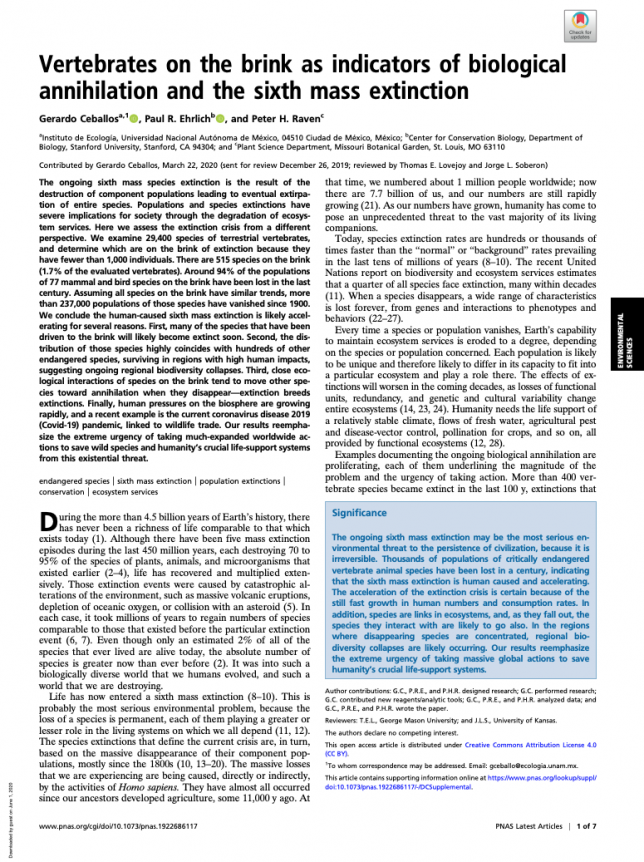The ongoing sixth mass species extinction is the result of the destruction of component populations leading to eventual extirpation of entire species. Populations and species extinctions have severe implications for society through the degradation of ecosystem services.
Research Article
Vertebrates on the brink as indicators of biological annihilation and the sixth mass extinction
Gerardo Ceballos, Paul R. Ehrlich, and Peter H. Raven, PNAS first published June 1, 2020. Contributed by Gerardo Ceballos, March 22, 2020 (sent for review December 26, 2019; reviewed by Thomas E. Lovejoy and Jorge L. Soberon).
The writers assess the extinction crisis from a different perspective. They examine 29,400 species of terrestrial vertebrates, and determine which are on the brink of extinction because they have fewer than 1,000 individuals. There are 515 species on the brink (1.7% of the evaluated vertebrates). Around 94% of the populations of 77 mammal and bird species on the brink have been lost in the last century. Assuming all species on the brink have similar trends, more than 237,000 populations of those species have vanished since 1900. They conclude the human-caused sixth mass extinction is likely accelerating for several reasons. First, many of the species that have been driven to the brink will likely become extinct soon. Second, the distribution of those species highly coincides with hundreds of other endangered species, surviving in regions with high human impacts, suggesting ongoing regional biodiversity collapses. Third, close ecological interactions of species on the brink tend to move other species toward annihilation when they disappear—extinction breeds extinctions. Finally, human pressures on the biosphere are growing rapidly, and a recent example is the current coronavirus disease 2019 (Covid-19) pandemic, linked to wildlife trade. Their results reemphasize the extreme urgency of taking much-expanded worldwide actions to save wild species and humanity’s crucial life-support systems from this existential threat.
![Terrestrial vertebrates on the brink (i.e., with 1,000 or fewer individuals) include species such as (A) Sumatran rhino (Dicerorhinus sumatrensis; image credit: Rhett A. Butler [photographer]), (B) Clarion island wren (Troglodytes tanneri; image credit: Claudio Contreras Koob [photographer]), (C) Española Giant Tortoise (Chelonoidis hoodensis; image credit: G.C.), and (D) Harlequin frog (Atelopus varius; the population size of the species is unknown but it is estimated at less than 1,000; image credit: G.C.).](https://www.activist360.co/wp-content/uploads/2020/06/F1.large_-644x451.jpg)
(CC BY-NC-ND 4.0)

